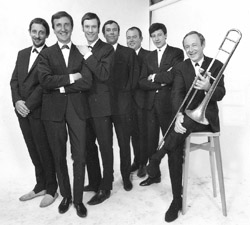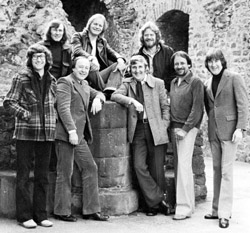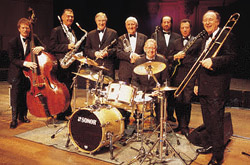 |
||||||||||||
| Part Two of the Chris Barber Story, written by Julian Purser, gives an overview of developments within the Chris Barber Band between the mid-1960s and the end of the 1990s. Part One tells the story of the band from the early days until the mid-1960s. | ||||||||||||
John Slaughter, too, is still present on blues guitar (yes, he did take a sabbatical for a few years, being replaced by the able Roger Hill from 1978 to 1985), and Vic Pitt continues to display his outstanding bass skills after 27 years in the band (he joined in 1977 after Jackie Flavelle, who had specialized more on the electric bass than the string bass, left after about ten years). Until recently, too, it could have been said that John Crocker, the great reedman, was also one of the continuing stalwarts, having joined in 1968. But he only stayed for 35 years (!) vacating the reed chair and being replaced by Trevor Whiting early in 2003. All in all, then, this unprecedented continuity over the years has helped the band retain its unique sound. In 1965 the band sported the conventional front line for a traditional jazz outfit: trumpet, trombone, and clarinet & saxophone. In 1978, as a harbinger of things to come, but in a sense stemming back to the first expansion when 19-year-old John Slaughter brought his electric blues guitar into the band in 1964, the band expanded to a four-man front line, with the addition of a second reedman. This chair was briefly filled by Sammy Rimington, and then by Ian Wheeler, who returned in 1978 after an absence of about ten years. Ian himself stayed for almost twenty years, his warm tone and gifted improvisations contributing once again to that unmistakable “Barber sound.” When Ian left for the second time, in 1998, he was replaced by the able John Defferary, who had played for many years in Denmark with Papa Bue’s Viking Jazz Band. As far as the rest of the band goes, the most recent long-term occupant of the banjo and guitar chair, the excellent and experienced Paul Sealey, was a member of the best rhythm section in traditional jazz for ten years beginning in 1994. Paul replaced Johnny McCallum, whose inventive contributions both on banjo and guitar added a new dimension to the band’s sound. Johnny himself was a member of the band for more than twenty years until he retired (the first member ever to do this directly), having replaced Steve Hammond (1971-73) and before Steve, Stu Morrison (1964 to 1971). In the mid-60s and on into the mid-70s, the drum chair was occupied by Graham Burbidge, then Pete York, who was replaced by Norman Emberson, and then by Alan “Sticky” Wickett, not once but twice, with a spell by the young Russell Gilbrook. Comparative newcomer Colin Miller now anchors the band in the drum chair. As most fans know, the band has no pianist: as Chris once said, he would have been happy to have a pianist, if that person were John Lewis (who did in fact tour with the band in 1978). Another pianist, the exotic and versatile Dr. John of New Orleans, was also a regular guest for much of the 1980s, and briefly rejoined Chris, Lonnie Donegan, and Van Morrison for The Skiffle Sessions in the late 1990s. Of course, the biggest single change to the band occurred in 2001, when the eight-man Jazz and Blues Band expanded to the eleven-piece Big Chris Barber Band – more about this in a later part of the Chris Barber Story. |
||||||||||||


